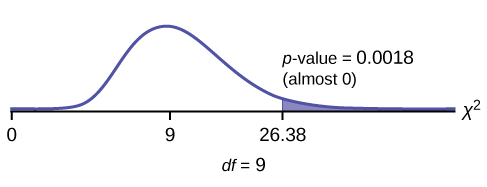| << Chapter < Page | Chapter >> Page > |
Students in a social studies class hypothesize that the literacy rates across the world for every region are 82%. [link] shows the actual literacy rates across the world broken down by region. What are the test statistic and the degrees of freedom?
| MDG Region | Adult Literacy Rate (%) |
|---|---|
| Developed Regions | 99.0 |
| Commonwealth of Independent States | 99.5 |
| Northern Africa | 67.3 |
| Sub-Saharan Africa | 62.5 |
| Latin America and the Caribbean | 91.0 |
| Eastern Asia | 93.8 |
| Southern Asia | 61.9 |
| South-Eastern Asia | 91.9 |
| Western Asia | 84.5 |
| Oceania | 66.4 |
degrees of freedom = 9
chi 2 test statistic = 26.38

Press
STAT and
ENTER . Make sure you clear lists
L1, L2, and
L3 if they have data in them. Into L1, put the observed frequencies
99, 99.5, 67.3, 62.5, 91, 93.8, 61.9, 91.9, 84.5, 66.4 . Into
L2 , put the expected frequencies
82, 82, 82, 82, 82, 82, 82, 82, 82, 82 . Arrow over to list
L3 and up to the name area
"L3" . Enter
(L1-L2)^2/L2 and
ENTER . Press
2nd QUIT . Press
2nd LIST and arrow over to
MATH . Press
5 . You should see
"sum" .
Enter L3 . Rounded to two decimal places, you should see
26.38 . Press
2nd DISTR . Arrow down to
7:χ2cdf (or press
7 ). Press
ENTER . Enter
26.38,1E99,9) . Rounded to four places, you should see
.0018 , which is the
p -value.
The newer TI-84 calculators have in
STAT TESTS the test
Chi2 GOF . To run the test, put the observed values (the data) into a first list and the expected values (the values you expect if the null hypothesis is true) into a second list. Press
STAT TESTS and
Chi2 GOF . Enter the list names for the Observed list and the Expected list. Enter the degrees of freedom and press
calculate or
draw . Make sure you clear any lists before you start.
Data from the U.S. Census Bureau
Data from the College Board. Available online at http://www.collegeboard.com.
Data from the U.S. Census Bureau, Current Population Reports.
Ma, Y., E.R. Bertone, E.J. Stanek III, G.W. Reed, J.R. Hebert, N.L. Cohen, P.A. Merriam, I.S. Ockene, “Association between Eating Patterns and Obesity in a Free-living US Adult Population.” American Journal of Epidemiology volume 158, no. 1, pages 85-92.
Ogden, Cynthia L., Margaret D. Carroll, Brian K. Kit, Katherine M. Flegal, “Prevalence of Obesity in the United States, 2009–2010.” NCHS Data Brief no. 82, January 2012. Available online at http://www.cdc.gov/nchs/data/databriefs/db82.pdf (accessed May 24, 2013).
Stevens, Barbara J., “Multi-family and Commercial Solid Waste and Recycling Survey.” Arlington Count, VA. Available online at http://www.arlingtonva.us/departments/EnvironmentalServices/SW/file84429.pdf (accessed May 24,2013).
To assess whether a data set fits a specific distribution, you can apply the goodness-of-fit hypothesis test that uses the chi-square distribution. The null hypothesis for this test states that the data come from the assumed distribution. The test compares observed values against the values you would expect to have if your data followed the assumed distribution. The test is almost always right-tailed. Each observation or cell category must have an expected value of at least five.

Notification Switch
Would you like to follow the 'Introductory statistics' conversation and receive update notifications?